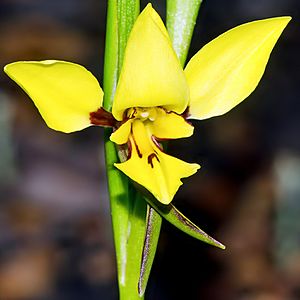Bristly donkey orchid facts for kids
Quick facts for kids Bristly donkey orchid |
|
|---|---|
 |
|
| Scientific classification | |
| Genus: |
Diuris
|
| Species: |
setacea
|
The bristly donkey orchid (scientific name: Diuris setacea) is a special type of orchid found only in the south-west part of Western Australia. It gets its name because its flowers look a bit like a donkey's ears! This unique plant has a bunch of twisted leaves at its base. It grows yellow flowers with some brown spots. You can often find it in wet soil on rocky areas. After a bushfire, these orchids often bloom much more!
Contents
What Does the Bristly Donkey Orchid Look Like?
This amazing orchid grows from a special underground part, like a small potato, and lives for many years. It has about six to ten leaves that twist around each other at the bottom of the plant. These leaves are usually about 5 to 10 centimetres (2 to 4 inches) long.
The plant grows a tall stem, about 15 to 30 centimetres (6 to 12 inches) high. On this stem, you'll find two to seven bright yellow flowers. Each flower is about 2.5 to 3 centimetres (1 to 1.2 inches) long and 2 to 3 centimetres (0.8 to 1.2 inches) wide. They often have some brown markings, making them even more interesting!
The top part of the flower, called the dorsal sepal, stands straight up. The side parts, called lateral sepals, point downwards. The petals are usually upright or bent back. The bottom part of the flower, called the labellum, has three main sections. It also has two small ridges outlined in brown.
These orchids usually flower from October to December. If there was a bushfire the summer before, you'll see many more of them blooming!
How Was This Orchid Named?
The bristly donkey orchid was first officially described in 1810 by a famous botanist named Robert Brown. He wrote about it in his book, Prodromus Florae Novae Hollandiae et Insulae Van Diemen.
The scientific name setacea comes from a Latin word, seta, which means "bristle." This probably refers to the bristly or hair-like appearance of some parts of the plant.
Where Does This Orchid Grow?
You can find the bristly donkey orchid growing in low, open areas with moist soil. It especially likes to grow on rocky outcrops made of granite. Its habitat stretches across Western Australia, from a town called Esperance all the way up to Kalbarri.
Is This Orchid Protected?
The Government of Western Australia's Department of Parks and Wildlife has looked at the bristly donkey orchid. They have classified it as "not threatened." This means that, for now, there are enough of these beautiful orchids in the wild, and they are not considered to be in danger.

